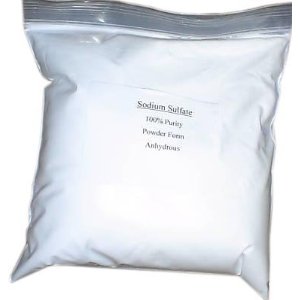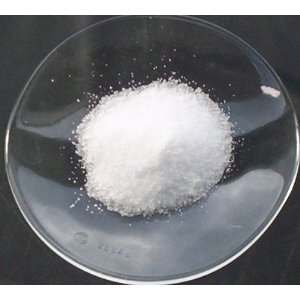How can I substitute sodium sulfate decahydrate for anhydrous sodium sulfate, for use as Glauber's Salt in dyeing fabric?
How can I substitute sodium sulfate decahydrate for anhydrous sodium sulfate, for use as Glauber's Salt in dyeing fabric?
Name: Tiffany
—ADVERTISEMENTS—

Sodium Sulfate Anhydrous, 5 lb
Sodium sulfate is the sodium salt of sulfuric acid. Anhydrous, it is a white crystalline solid of formula Na2SO4. Sodium sulfate is mainly used for the manufacture of detergents and in the Kraft process of paper pulping. About two thirds of the world's production is from mirabilite, the natural mineral form of the decahydrate, and the remainder from by-products of chemical processes such as hydrochloric acid production. This product is made in the USA.

5 Lb Sodium Sulfate Anhydrous
Sodium Sulfate has many uses. Great for hobbies and crafts including soap making. Used as a conditioning water filler in detergents. Absorbs water; great for drying most organic compounds. Can be used in passive solar heating systems. Chemistry experiments laboratory reagent.
Country or region: Canada
Message: I have recently come across an issue with sodium sulfate decahydrate. I recently purchased Glauber's salt from Dharma's. I ran out and my hubby bought more from the chem supply at the university he works at. Now I have discovered that Dharma's Glauber's salt is actually anhydrous sodium sulfate. I now have 1 KG ($84) of sodium sulfate decahydrate. Can I even use this? If so, how much would I use for one pound of fabric?
"Anhydrous" means that the form of the sodium sulfate molecule does not include any water molecules complexed with it. "Decahydrate" means that, as in washing soda, each molecule of the chemical has ten molecules of water attached within its crystalline structure.
According to Doug Wilson's Dyes and Dyeing Glossary [PDF], "In the dye industry, some use 'sodium sulfate' to refer to the anhydrous form, and 'Glauber’s salt' only to refer to the decahydrate form." That is not universally true, however, which is why Wilson said "some". The MSDS of the Glauber's salt sold by Dharma describes it as anhydrous, as does the description in the catalog. Other dye suppliers, such as PRO Chemical & Dye, also supply the anhydrous form.
When using Glauber's salt as a diluent for dye powders, whether to make them a standard strength or to make it easier to measure out suitable quantities for dyeing pale colors, it's good to avoid the extra water content of the decahydrate form of Glauber's salt, since the anhydrous form of sodium sulfate is useful for keeping other chemicals dry. Keeping dye powder absolutely dry is important for long storage. However, since you will most likely be using your Glauber's salt, of whichever form, only when dissolved in water, it will not matter at all which you use. You'll have plenty of water present anyway, at that point. The only question is how much of your sodium sulfate powder to measure out to use.
The decahydrate form of a substance is always larger and heavier than the anhydrous form, thanks to the presence of all those water molecules. The molecular weight of anhydrous sodium sulfate is 142.04 grams per mole, while the molecular weight of sodium sulfate decahydrate is 322.20 grams per mole (where "mole" is a certain specific number of molecules). This means that 142 grams of the anhydrous form contains the same number of sodium sulfate molecules as 322 grams of the decahydrate. 1000 grams of sodium sulfate decahydrate is equivalent to 441 grams of anhydrous sodium sulfate; 1000 grams of anhydrous sodium sulfate is equivalent to 2268 grams of sodium sulfate decahydrate.
It's most accurate to use weight rather than volume for measuring the amounts you use of dyes and dye auxiliaries; however, measuring by volume is often more convenient. The density of the anhydrous form is listed as 2.664 grams per milliliter, while the density of the decahydrate is listed as 1.464 grams per milliliter. This implies that 15 ml, or one tablespoon, of the decahydrate is equivalent to 8 ml of the anhydrous form, which is a little more than one and a half teaspoons.
How much should you use for one pound of fabric? That depends very much on what fiber you are dyeing, on what type of dye you are using, and on what method you are using to apply the dye. Find a reliable recipe, possibly one supplied by your dye retailer, and follow it closely, except for multiplying the amount of Glauber's salt by a factor of 1.8 when measuring by volume, or by a factor of 2.3 when measuring by weight, to correct for using the decahydrate form of sodium sulfate rather than the anhydrous form. I would not bother to use Glauber's salt at all for tie-dyeing cotton, for example. You can choose to substitute it for the salt (sodium chloride) in the high water ratio immersion dyeing of cotton with fiber reactive dye, using a five-gallon bucket or a washing machine. Glauber's salt is more important in dyeing wool. For dyeing wool with ProChem's Washfast Acid Dyes, you would use one tablespoon (which ProChem lists as weighing 15 grams) of anhydrous sodium sulfate while dyeing one pound of wool, or, for the same effect, substitute 34 grams (two tablespoons plus one scant teaspoon) of the decahydrate.
An interesting point about Glauber's salt is that, in addition to its important special properties for dyeing wool, it is also said to increase the color yield when dyeing with copper phthalocyanine fiber reactive dyes, such as Procion Turquoise MX-G. It will brighten the turquoise more than other colors of the same class of dye. As a result, if you substitute Glauber's salt for sodium chloride (ordinary table salt) when dyeing with color mixtures that include turquoise, you will obtain a different color than is predicted by the color chip on the chart for the dye color. Many of the different pre-mixed Procion dye colors include turquoise as an ingredient; Dharma even marks which of their premixed Procion colors contain it, in their catalog. If you care about producing a color very close in hue to the printed color chip from the catalog or the website, when using one of these pre-mixed colors, you should avoid substituting sodium sulfate for sodium chloride, as doing so will change the color, shifting the color to make it more blue. It's not a universal bluing effect, however; it will not make any other blue dye more blue, only those blue dyes that happen to be based upon the copper phthalocyanine molecule.
By the way, I think the purity of the sodium sulfate decahydrate from your husband's chemistry supply department may be higher than you need for dyeing. $84 is a lot for a kilogram of sodium sulfate decahydrate, given that G&S Dye, in Toronto, sells it for $2.75 per kilo, while Maiwa in Vancouver sells it for $8 per kilo (in Canadian dollars).
(Please help support this web site. Thank you.)
Posted: Wednesday - September 14, 2011 at 08:07 AM
Follow this blog on twitter here.
Quick Links
- All About Dyes & Dyeing Top -
- Top of this blog -
- FAQ -
- The Dye Forum -
- How to Tie Dye - How to Batik -
- Books - Toys - Plants -
- Top of this blog -
- FAQ -
- The Dye Forum -
- How to Tie Dye - How to Batik -
- Books - Toys - Plants -
More in this category:
- -
Statistics
Total entries in this blog:
Total entries in this category:
Published On: Aug 29, 2012 02:49 PM
Total entries in this category:
Published On: Aug 29, 2012 02:49 PM